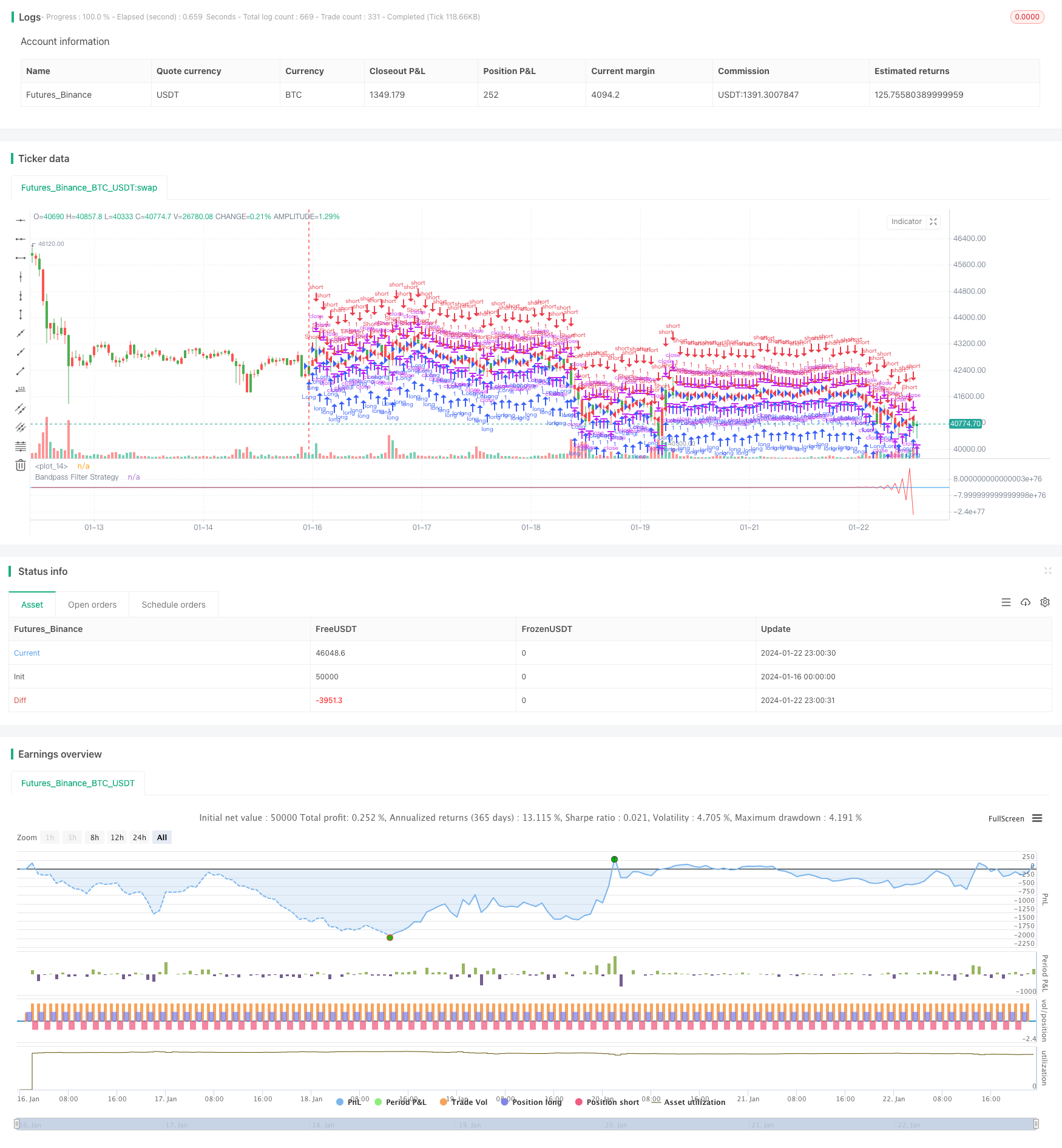
概述
带通滤波反转策略是一种基于带通滤波器的股票交易策略。它通过构建一个cos和正弦函数,来模拟一个带通滤波器,并生成买入和卖出信号。当滤波器输出高于或低于某个触发水平时,该策略会进行反向操作,即买入或卖出。
策略原理
该策略的核心是构建一个带通滤波器BP,它由两个参数组成:中心频率和带宽。中心频率决定了滤波器通过的主要周期,带宽决定了通过的周期范围。这些参数决定了滤波器的传递特性。
具体来说,该策略构建了以下几个变量:
- Length:滤波器的中心周期
- Delta: 带宽参数
- Beta:与中心频率相关的系数
- Gamma:与带宽相关的系数
- Alpha:与Beta、Gamma有关的中间变量
根据这些变量,策略构建出了一个一阶IIR(无限脉冲响应)滤波器:
BP = 0.5*(1 - alpha)*(xPrice - xPrice[2]) + beta*(1 + alpha)*nz(BP[1]) - alpha*nz(BP[2])
当BP高于或低于TriggerLevel时,该策略会进行相反方向的操作。
优势分析
该策略的主要优势有:
- 使用带通滤波器,可以滤除高频和低频噪声,只提取 Useful的中频周期信号,提高信噪比。
- 相对简单直观,只需要调整几个参数,就可以适应不同周期和市场环境。
- 采用反转策略,可以及时捕捉价格短期反转现象,获利后快速平仓,降低持仓风险。
风险分析
该策略也存在一些风险:
- 带通滤波器的参数设置需要根据不同周期和市场环境调整,如果设置不当,会错过交易机会或者产生更多错误信号。
- 反转策略容易受到错觉反转的影响, если反转不成立、价格继续原方向运行,会造成损失。
- 交易频率可能较高,需要注意防止超优化,并控制交易成本。
为了降低这些风险,可以考虑以下几个优化方法:
- 采用自适应滤波器,根据市场变化自动调整参数。
- 结合趋势过滤器,避免逆势开仓。
- 优化参数组合,使策略参数化,适应更多市场情况。
优化方向
该策略主要可以从以下几个方面进行优化:
周期和参数自适应:根据不同周期及最近一个时间窗口的价格行情,实时调整 Length、Delta 等参数,使滤波器动态适应市场环境变化。
结合趋势判断:在带通滤波器基础上加入 MACD、MA 等技术指标判断趋势方向,避免逆势开仓。
多时间框架结合:在多个时间框架(例如 5 分钟、15 分钟、30 分钟等)部署策略,不同时间框架之间进行信号验证,提高信号准确率。
4.止损机制:设定合理的止损位置,在亏损达到止损位后主动平仓止损,有效控制单笔亏损大小。
通过以上几点优化,可以大幅提高策略的稳定性、适应性和盈利能力。
总结
带通滤波反转策略通过构建带通滤波器,提取有用的中频信号,并在滤波器输出触发水平时,采取反向操作,捕捉价格的短期反转机会。该策略相对简单,通过参数优化可以适应多种市场环境。主要优化方向包括自适应滤波器、趋势判断、多时间框架组合及止损机制等。
/*backtest
start: 2024-01-16 00:00:00
end: 2024-01-23 00:00:00
period: 1h
basePeriod: 15m
exchanges: [{"eid":"Futures_Binance","currency":"BTC_USDT"}]
*/
//@version = 2
////////////////////////////////////////////////////////////
// Copyright by HPotter v1.0 24/11/2016
// The related article is copyrighted material from
// Stocks & Commodities Mar 2010
// You can use in the xPrice any series: Open, High, Low, Close, HL2, HLC3, OHLC4 and ect...
// Please, use it only for learning or paper trading. Do not for real trading.
////////////////////////////////////////////////////////////
strategy(title="Bandpass Filter Reversed Strategy")
Length = input(20, minval=1)
Delta = input(0.5)
TriggerLevel = input(0)
xPrice = hl2
hline(TriggerLevel, color=blue, linestyle=line)
beta = cos(3.14 * (360 / Length) / 180)
gamma = 1 / cos(3.14 * (720 * Delta / Length) / 180)
alpha = gamma - sqrt(gamma * gamma - 1)
BP = 0.5 * (1 - alpha) * (xPrice - xPrice[2]) + beta * (1 + alpha) * nz(BP[1]) - alpha * nz(BP[2])
pos = iff(BP > TriggerLevel, -1,
iff(BP <= TriggerLevel, 1, nz(pos[1], 0)))
if (pos == 1)
strategy.entry("Long", strategy.long)
if (pos == -1)
strategy.entry("Short", strategy.short)
barcolor(pos == -1 ? red: pos == 1 ? green : blue )
plot(BP, color=red, title="Bandpass Filter Strategy")